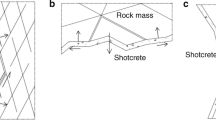Abstract
To solve the problem on the serious loss of bond strength of shotcrete in hot and dry environments, the measures for improving the bond strength were explored by mixing mineral admixtures or fiber materials into shotcrete mixture. The bond strengths between shotcrete and rock in hot and dry environments were measured by splitting method, and macroscopic, mesoscopic and microscopic analyses were carried out on shotcrete specimens. The results show that: in hot and dry environments, the bond strengths all decrease when mixed with mineral admixtures, and especially for the fly ash, with which the bond strength of shotcrete decreases by 36.7%. Mixing polypropylene fibers into shotcrete makes its bond strength decrease by 10.2%, but for steel fibers, it will be improved by 41.8% compared with basic mix proportion. Moreover, according to submicroscopic measurement and microscopic analysis, the influence mechanisms of mineral admixtures and fiber materials have been explored to some extent. Therefore, it’s feasible and effective to improve the bond strength by adding steel fibers in hot and dry environment.
Similar content being viewed by others
References
Chen, G. Q., Li, T. B., and Zhang, G. F. (2014). “Temperature effect of rock burst for hard rock in deep-buried tunnel.” Natural Hazards, Vol. 72, No. 2, pp. 915–926.
Cui, S. A., Li, J. W., and Ye, Y. Z. (2013). “Bond strength of shotcrete with Rock in dry and hot environment of high ground temperature tunnel.” Journal of Building Materials, Vol. 16, No. 4, China, pp. 663–666 and pp. 682.
GB50086 (2001). Specifications for bolt-shotcrete support, Beijing, China
GB/T50081 (2002). Standard for test method of mechanical properties on ordinary concrete, Beijing, China
Grudemo, A. (1979) “Microcracks, fracture mechanism and strength of the cement paste matrix.” Cement and Concrete Research, Vol. 4, Sweden, pp.19–33.
Gu, B. S. (2007). “Counter measures against high temperature in a tunnel and the corresponding ventilation design—Feasibility study for the super-long Gaoligongshan tunnel.” Modern Tunneling Technology, Vol. 44, No. 2, China, pp. 66–71.
He, M. C. (2009). “Application of HEMS cooling technology in deep mine heat hazard control.” Mining science and techonology, Vol. 19, No. 3, pp. 269–275, DOI: 10.1016/S1674-5264(09)60051-X.
Hochstein, M. P. and Prebble, W. M. (2006). “Major engineering constructions on top of a high-temperature geothermal system: problems encountered at Tokaanu.” Geothermics, Vol. 35, No. 4, New Zealand, pp. 428–447, DOI: 10.1016/j.geothermics.2006.06. 001.
Huang, S. Y. (1982). “SEM observations of the structure of fly ash cement pastes.” Journal of Wuhan Institute of Building Materials, No. 2, China, pp. 255–260.
Leung, C. K., Lai, R., and Lee, A. Y. F. (2005). “Properties of wetmixed fiber reinforced shotcrete and fiber reinforced concrete with similar composition.” Cement and Concrete Research, Vol. 35, pp. 788–795.
Li, X. Q. and Dai, L. X. (2011). “Cooling technology for construction of high earth temperature section of a diversion tunnel.” Water Resources and Hydropower Engineering, Vol. 42, No. 2, China, pp. 36–41.
Rocco, C., Guinea, G., Planas, J., and Elices, M. (1998). “Experimental analysis of rupture mechanisms in the Brazilian test.” In: Mihashi et al eds., Fracture Mechanics of Concrete Structures, Proceedings FRAMCOS-3, AEDIFICATIO Publishers, Germany, pp. 121–130.
Wilhelm, J. and Rybach, L. (2003). “The geothermal potential of Swiss Alpine tunnels.” Geothermics, Vol. 32, No. 4, Switzerland, pp. 557–568, DOI: 10.1016/S0375-6505(03)00061-0.
Su, H., Zhang, H., and Geng, X. C. (2014). “Hydropower tunnel in high geothermal condition: influences of high ground temperature and countermeasures.” Tunnel Construction, Vol. 34, No. 4, China, pp. 351–355.
Zhao, G. B., Cheng, X. M., and Sun, X. N. (2013). “Manifestation and countermeasure of high geo-temperature of Qirehataer hydro-power station diversion tunnel.” Resource Environment & Engineering, Vol. 27, No. 4, China, pp. 566–567 and pp. 591.
Zhao, T. X. and Yan, M. F. (2001). “Temperature lowering technique for hot water with high pressure in Heibaishui Ladder-shaped power station tunnel.” Modern Tunnelling Technology, Vol. 38, No. 3, China, pp. 48–51.
Author information
Authors and Affiliations
Corresponding author
Rights and permissions
About this article
Cite this article
Cui, S., Xu, D., Liu, P. et al. Exploratory study on improving bond strength of shotcrete in hot and dry environments of high geothermal tunnels. KSCE J Civ Eng 21, 2245–2251 (2017). https://doi.org/10.1007/s12205-016-0901-y
Received:
Accepted:
Published:
Issue Date:
DOI: https://doi.org/10.1007/s12205-016-0901-y




